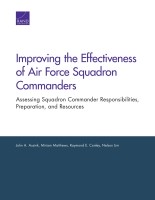| 来源类型 | Research Reports
|
| 规范类型 | 报告
|
| DOI | https://doi.org/10.7249/RR2233
|
| ISBN | 9780833099457
|
| 来源ID | RR-2233-AF
|
| Improving the Effectiveness of Air Force Squadron Commanders: Assessing Squadron Commander Responsibilities, Preparation, and Resources |
| John A. Ausink; Miriam Matthews; Raymond E. Conley; Nelson Lim
|
| 发表日期 | 2018
|
| 出版年 | 2018
|
| 页码 | 100
|
| 语种 | 英语
|
| 结论 |
Squadron Commanders Find Duties That Are Not Recognized and Not Resourced Appropriately Can Interfere with Mission Performance- Commanders expressed concerns regarding addressing multiple taskers and administrative duties.
- Speaking of the burden of "additional duties," commanders often are not referencing the responsibilities the Air Force officially designates as additional duties. Rather, they are often referring to other duties they recognize as being necessary to maintain the squadron but for which they believe they do not have sufficient resources.
Commander Preparation Can Vary, and Commanders Want More Information on Elements of How to Command- Potential preparation differences include rates of in-residence attendance for intermediate developmental education, assignments to headquarters, and experiences in operations-officer-like positions before assuming command.
- There is little overlap in the topics covered in the squadron commander preparation courses offered by major commands.
- Areas in which squadron commanders expressed interest in additional training included more information on how to command, administrative requirements, and disciplinary issues.
Commanders Are Concerned About Squadron Manning Levels and the Need for More Personnel- They expressed concerns not only about the total number of people in the squadron but also about the distribution of people with the right skills and experience.
- Squadron commanders recognize Air Force efforts to increase commander support staff manning and often spoke in positive terms about the additional staffing. Some expressed concerns about defining the duties for the new personnel, the amount of time to fill those positions, and the amount of time to train new personnel assigned to those positions.
|
| 摘要 |
- Continue to review Air Force Instructions (AFIs), and record the number of responsibilities levied on squadron commanders. Eliminate responsibilities that are not essential.
- Evaluate the level of waiver authorities within AFIs to determine if authorities at a lower level than currently listed could be allowed to grant waivers with minimal risk.
- Major commands, Headquarters Air Force, and functionals should track information regarding the number of taskers they disseminate and readily provide this information to commanders.
- Increase standardization of major command squadron preparation courses.
- Provide additional training to squadron commanders on Air Force personnel management systems, disciplinary procedures, and money management.
- Provide promising Air Force personnel with a diversity of leadership experiences and opportunities to work with commanders.
- The Air Force should identify resource categories of interest and establish resource standards in those categories.
- More regularly review and update manpower standards to reflect current responsibilities.
- Provide guidelines regarding the responsibilities new commanders' support staff should assume and the length of time they will need to become fully functional.
|
| 主题 | Military Command and Control
; Military Education and Training
; Organizational Leadership Development
; United States Air Force
|
| URL | https://www.rand.org/pubs/research_reports/RR2233.html
|
| 来源智库 | RAND Corporation (United States)
|
| 引用统计 |
|
| 资源类型 | 智库出版物
|
| 条目标识符 | http://119.78.100.153/handle/2XGU8XDN/108768
|
推荐引用方式
GB/T 7714 |
John A. Ausink,Miriam Matthews,Raymond E. Conley,et al. Improving the Effectiveness of Air Force Squadron Commanders: Assessing Squadron Commander Responsibilities, Preparation, and Resources. 2018.
|
|
文件名:
|
x1526676724949.jpg
|
|
格式:
|
JPEG
|

|
文件名:
|
RAND_RR2233.pdf
|
|
格式:
|
Adobe PDF
|
除非特别说明,本系统中所有内容都受版权保护,并保留所有权利。